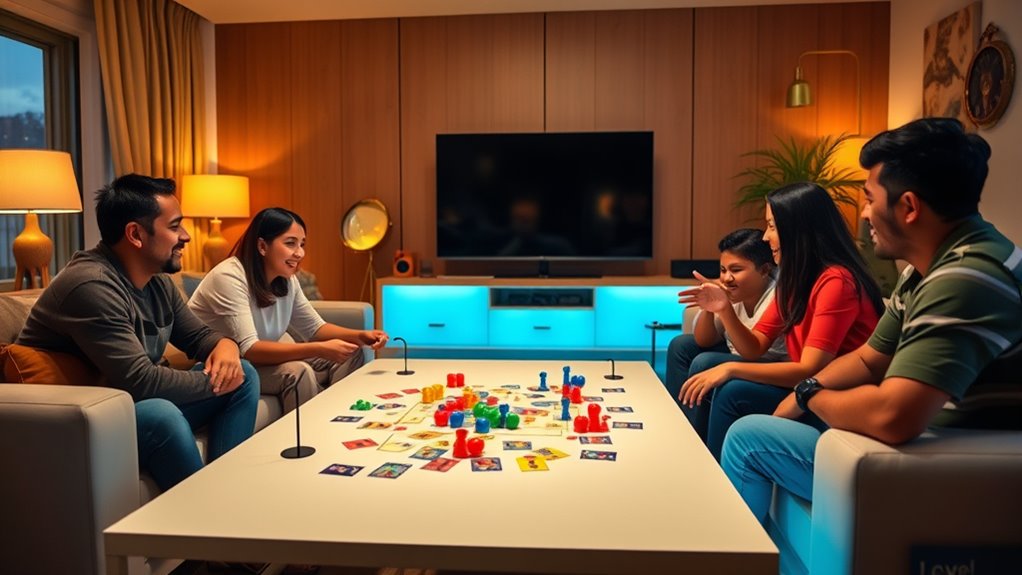For a family game night that levels the audio playing field, focus on activities that don’t rely on loud sounds or music. Opt for classic board games, card games, charades, or storytelling activities that encourage face-to-face interaction. Incorporate quiet music in the background or use vibrations and visual cues to include everyone. Balancing these ideas helps create a fun, inclusive atmosphere—stay tuned for more ways to make your evening unforgettable.
Key Takeaways
- Incorporate silent or low-volume music activities like musical trivia or family playlists to create shared musical experiences without overwhelming noise.
- Choose device-free, tactile games such as board games, charades, or storytelling to promote interaction and reduce background audio issues.
- Use visual cues and written instructions in games to accommodate hearing sensitivities and ensure everyone stays engaged.
- Limit or turn off background music during certain activities to prevent audio overload and maintain focus on game play.
- Design a balanced mix of lively music-based activities and quiet, inclusive games to cater to diverse preferences and sensitivities.

Family game nights are a perfect way to bring everyone together and create lasting memories. If you’re looking to make your evenings more engaging and inclusive, consider adding music-themed activities and tech-free game options to your routine. These ideas help level the audio playing field, ensuring that no one feels left out, whether they’re sensitive to loud sounds or prefer more interactive, hands-on fun.
Family game nights bring everyone together with fun, inclusive activities that suit all preferences and sensitivities.
Start by incorporating music-themed activities that everyone can enjoy. For example, you could organize a game of musical chairs, where players race around chairs while music plays and scramble to find a seat when it stops. It’s a lively, energetic activity that gets everyone moving. Alternatively, try a musical trivia game where you play snippets of songs and challenge your family to identify the tune or artist. This not only sparks friendly competition but also introduces a fun way to share musical tastes and learn new tracks together. You can also create a family playlist and have each member take turns choosing songs to set the mood for the night. Playing music silently in the background can keep the atmosphere lively without overwhelming anyone’s hearing, especially if some family members prefer quieter environments.
To guarantee everyone can participate fully, it’s essential to include tech-free game options. These provide a break from screens and foster genuine interaction. Classic board games like Scrabble, Clue, or Settlers of Catan are excellent choices, encouraging strategic thinking and conversation. Card games such as Uno or Go Fish are simple yet entertaining, and you can easily adapt them to suit all ages. For a creative twist, you might try charades or Pictionary, which require no devices and rely solely on acting or drawing. These games promote laughter and teamwork, helping family members connect on a deeper level. If your family enjoys storytelling, consider playing “story cubes” or improvisation games that stimulate imagination and spontaneous fun. Incorporating tuning options from various activities can help cater to different preferences and keep the energy balanced.
Balancing music-themed activities with tech-free options guarantees everyone’s preferences are considered, making your family game night more inclusive and enjoyable. Limiting the use of electronic devices keeps the focus on face-to-face interaction, strengthening bonds and creating shared experiences. Whether you’re dancing to favorite tunes, competing in a board game, or acting out clues, these activities help create a warm, lively atmosphere where everyone feels involved. By mixing music with classic, device-free games, you make your family nights more dynamic, memorable, and accessible for all ages and hearing sensitivities. Ultimately, it’s about having fun together and enjoying each other’s company, free from distractions and loud distractions.
Frequently Asked Questions
How Can I Ensure Fair Audio Levels for All Players?
To guarantee fair audio levels for everyone, start by adjusting the volume control on each device or microphone, setting them to a consistent level. Use sound mixing techniques, like equalizing and balancing audio inputs, to prevent one voice or sound from overpowering others. Regularly check and tweak these settings during gameplay to maintain clarity and fairness, making sure all players hear equally without straining or missing out.
What Equipment Is Needed to Balance Game Audio?
Ever wonder what equipment can help balance game audio? To achieve even sound levels, you’ll need a good microphone, a mixer, and speakers. Proper speaker placement is key—position them at ear level and equidistant from players. Soundproofing techniques, like foam panels, minimize echo and background noise. These tools guarantee everyone hears clearly, making game night more fun and fair for all players.
How Do I Handle Varying Hearing Abilities in the Family?
When handling varying hearing abilities, you can use hearing aids for those who need them, ensuring everyone hears clearly. Additionally, incorporate sound therapy techniques to improve auditory focus and comfort. Adjust the game volume and provide visual cues to support players with hearing challenges. By combining these approaches, you create an inclusive environment where all family members can enjoy game night without frustration or exclusion.
Are There Specific Games That Naturally Promote Audio Fairness?
Think of these games as a balanced orchestra, where everyone’s voice matters equally. You can choose games that naturally promote audio fairness, like charades or visual clue games, reducing reliance on voice modulation. Incorporate soundproofing techniques around play areas to minimize background noise and help everyone hear clearly. By selecting such games and creating an acoustically friendly environment, you guarantee all players, regardless of hearing ability, can enjoy the fun equally.
How Can I Troubleshoot Audio Issues During Game Night?
When troubleshooting audio issues during game night, start with proper audio calibration to guarantee all players hear equally. Check your device settings and adjust volume levels if needed. Consider using soundproofing techniques, like adding rugs or curtains, to reduce echo and background noise. Test your sound equipment beforehand and keep backup options handy. These steps help create a fair, enjoyable experience for everyone, regardless of their position in the room.
Conclusion
Picture your family gathered around the table, laughter filling the room as everyone’s voice blends seamlessly with the joyful sounds of a game. With these ideas, you’ll create a welcoming space where everyone feels heard and connected. Imagine the warm glow of snacks, the clatter of game pieces, and the shared excitement in the air. Turn your family game night into a harmonious celebration, where every voice matters and memories are made with every turn.











